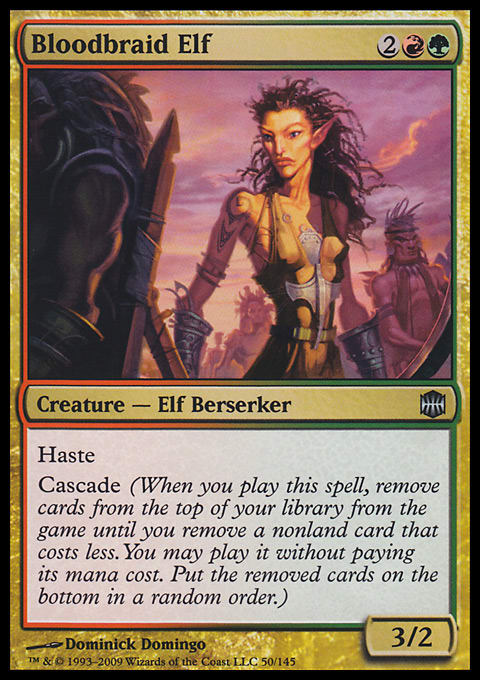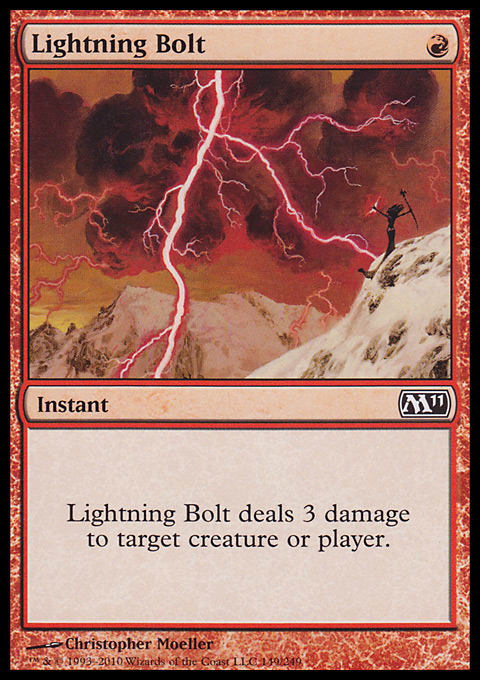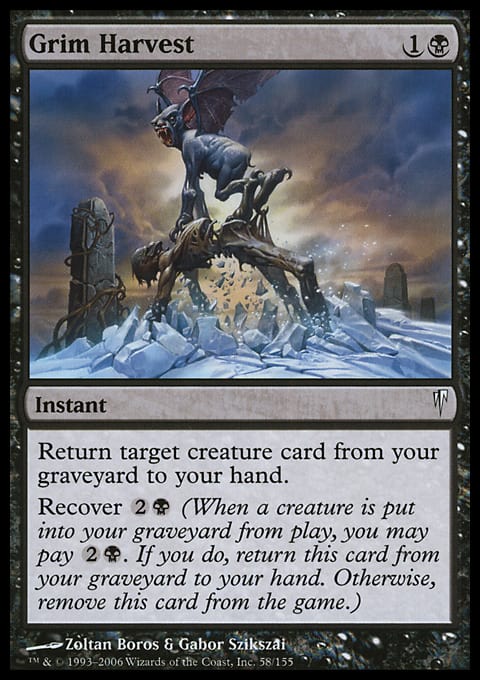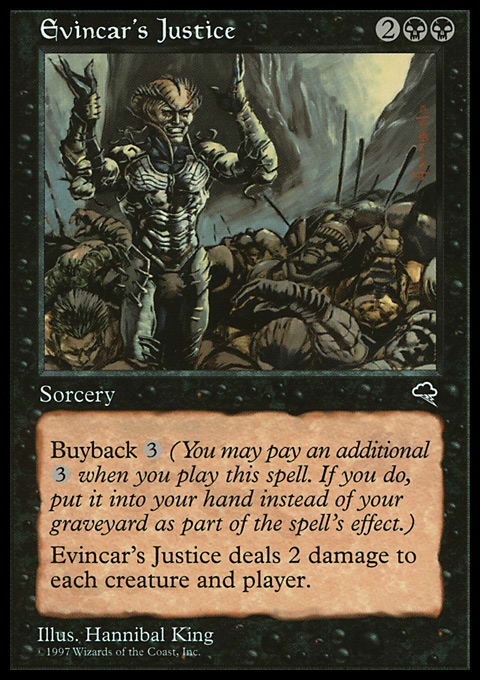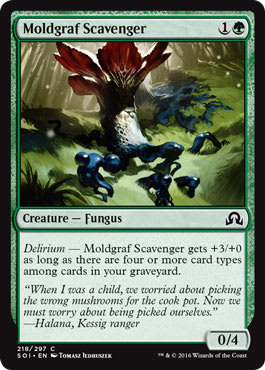It happens every week. Someone posts a thread to the Pauper Reddit asking about Jund. Whether it’s someone posting their supposedly awesome list or a person looking for help, a new thread on Black-Red-Green deck emerges on a regular basis. The usual suspects all make an appearance — Putrid Leech, Blightning, Night's Whisper, Terminate — but rarely does such a deck get a moment in the spotlight (also known as posting a 5-0 finish). Yet this does not stem the tide of threads. A few days ago Mike from the podcast Color Commontary asked me why Pauper seemed to have a preoccupation with Jund. My reply planted the seed for this article.
Before we can explore what it is to Jund (and why it may not work as well as desired in Pauper) we must first understand the ancestor that is the Rock.
Good Ol’ Rock
Back in the days of Urza’s Saga/Mercadian Masques there existed a B/G deck that, at the time, defied definition. This was before Midrange became a distinct theoretical archetype and instead people use the terms aggro, control, and combo almost exclusively. The Rock (as it was known) was a creature based (aggro) deck that sought to dictate board position (control). At the same time the deck was not Blue and lacked any tempo elements (a hallmark of the hybrid Aggro-Control archetype). "The Rock" in this case was Phyrexian Plaguelord; his "Millions" (yup, the deck is named after Dwayne "The Rock" Johnson) were the other creatures used as fodder to facilitate wiping the board. Yavimaya Elder and Deranged Hermit were fuel to the engine. Innovated by Sol Malka, The Rock became a go to name for any B/G deck:
The Rock ? Nemesis Standard | Sol Malka
- Creatures (25)
- 1 Llanowar Elves
- 1 Woodripper
- 3 Yavimaya Elder
- 4 Albino Troll
- 4 Birds of Paradise
- 4 Deranged Hermit
- 4 Phyrexian Plaguelord
- 4 Yavimaya Granger
- Instants (5)
- 2 Vampiric Tutor
- 3 Rapid Decay
- Sorceries (4)
- 4 Duress
- Enchantments (3)
- 1 Tranquil Grove
- 2 Diabolic Servitude
- Lands (23)
- 11 Forest
- 6 Swamp
- 2 Dust Bowl
- 4 Treetop Village
The result was that the Rock became defined as any deck that tried to gain an incremental advantage with board presence and was typified by a small top end. If this sounds anything like Midrange that's because it is — the Rock was the first true midrange deck. It tended to be base B/G because those were the best colors for creatures and disruption. There were more aggressive versions (with Rancor) and different top ends (Spiritmonger) but the core remained the same. As time went on common inclusions were Living Wish, Pernicious Deed, Genesis, Duress, Cabal Therapy, and others.
The Rock ? Extended | Darwin Kastle; Pro Tour Houston 2001
- Creatures (14)
- 2 Spiritmonger
- 4 Birds of Paradise
- 4 Llanowar Elves
- 4 Yavimaya Elder
- Instants (9)
- 1 Naturalize
- 4 Diabolic Edict
- 4 Vampiric Tutor
- Sorceries (6)
- 1 Chainer's Edict
- 1 Living Wish
- 4 Cabal Therapy
- Enchantments (4)
- 4 Pernicious Deed
- Lands (23)
- 7 Forest
- 7 Swamp
- 1 Dust Bowl
- 4 Llanowar Wastes
- 4 Treetop Village
- Sideboard (15)
- 1 Dust Bowl
- 1 Faceless Butcher
- 1 Genesis
- 1 Haunting Echoes
- 1 Living Death
- 1 Masticore
- 2 Naturalize
- 1 Planar Void
- 4 Ravenous Baloth
- 1 Spiritmonger
- 1 Stronghold Taskmaster
At various points in Extended's history other colors were added. White was sometimes splashed for Swords to Plowshares (Junk, pre Abzan) and Destructive Flow was played for one or two seasons (Red Rocks).
So what's the appeal? Big creatures, incremental advantage, and flexibility. The Rock, in theory, should be able to handle just about anything the format throws at it provided it is tuned correctly. Rock also often acts as "Rock" in Rock-Paper-Scissors metagames — it is the starting point. In Pauper, the closest thing there is to the Rock is Mono-Black Control.
Mono-Black Control ? Pauper | ieatkittens, 5-0 Pauper League, November 25, 2016
- Creatures (17)
- 1 Faerie Macabre
- 1 Gurmag Angler
- 3 Liliana's Specter
- 4 Chittering Rats
- 4 Gray Merchant of Asphodel
- 4 Phyrexian Rager
- Instants (11)
- 1 Echoing Decay
- 1 Geth's Verdict
- 1 Grim Harvest
- 2 Victim of Night
- 3 Disfigure
- 3 Tendrils of Corruption
- Sorceries (8)
- 2 Chainer's Edict
- 2 Corrupt
- 4 Sign in Blood
- Enchantments (1)
- 1 Pestilence
- Lands (23)
- 21 Swamp
- 2 Barren Moor
- Sideboard (15)
- 1 Liliana's Specter
- 1 Chainer's Edict
- 3 Duress
- 2 Nausea
- 4 Rancid Earth
- 2 Relic of Progenitus
- 2 Wrench Mind
Mono-Black Control is a creature based midrange control deck that tries to accrue incremental advantage. Currently that advantage comes in two forms — cards (Chittering Rats, Phyrexian Rager) and Devotion (for a Gray Merchant of Asphodel kill). Where MBC falls short is its weapons against other elements. Black is very good at attacking the hand and creatures on the board but suffers in other areas. In my opinion this is why many players seek to find other answers to fill their midrange needs in Pauper.
Jund ‘Em Out
Jund is different than the Rock in that, while still a midrange deck (and still the Rock in its format), it subscribed to the "Best Cards" philosophy of deck-building. The premise of Jund (in its Standard) was that it played the best possible cards at every point on the curve (Putrid Leech on 2, Blightning on 3, Bloodbraid Elf on 4).
Jund ? Alara Reborn Standard | Simon Goertzen, Winner Pro Tour San Diego 2010
- Creatures (18)
- 3 Broodmate Dragon
- 3 Siege-Gang Commander
- 4 Bloodbraid Elf
- 4 Putrid Leech
- 4 Sprouting Thrinax
- Planeswalkers (2)
- 2 Garruk Wildspeaker
- Instants (4)
- 4 Lightning Bolt
- Sorceries (9)
- 2 Rampant Growth
- 3 Maelstrom Pulse
- 4 Blightning
- Lands (27)
- 3 Mountain
- 3 Swamp
- 4 Forest
- 1 Rootbound Crag
- 2 Dragonskull Summit
- 2 Lavaclaw Reaches
- 4 Raging Ravine
- 4 Savage Lands
- 4 Verdant Catacombs
- Sideboard (15)
- 1 Maelstrom Pulse
- 4 Deathmark
- 1 Pithing Needle
- 2 Terminate
- 4 Great Sable Stag
- 3 Master of the Wild Hunt
Jund was the Platonic Ideal of value and it was never bad in its format. Rather it was a baseline and gave clear lines to victory. Goertzen’s Pro Tour winning deck matched up exceptionally well with the field. One-for-one removal matched up poorly against Sprouting Thrinax and Broodmate Dragon while Putrid Leech blanked Lightning Bolt. The Rampant Growths allowed Goertzen the ability to jump the curve and start hitting his haymakers earlier while Garruk Wildspeaker provided a persistent form of card advantage.
The advent of Modern we saw Planeswalkers, and recurring advantage engines, become standard inclusions in the deck. Grim Flayer, Dark Confidant, Grim Lavamancer, Deathrite Shaman, and others found a home while Liliana of the Veil and others filled the role of Garruk in later builds.
Jund ? Modern| Reid Duke, 24 Points Pro Tour Oath of the Gatewatch
- Creatures (14)
- 2 Kalitas, Traitor of Ghet
- 2 Kitchen Finks
- 2 Scavenging Ooze
- 4 Dark Confidant
- 4 Tarmogoyf
- Planeswalkers (4)
- 4 Liliana of the Veil
- Instants (10)
- 1 Kolaghan's Command
- 1 Slaughter Pact
- 2 Abrupt Decay
- 2 Terminate
- 4 Lightning Bolt
- Sorceries (7)
- 1 Maelstrom Pulse
- 2 Thoughtseize
- 4 Inquisition of Kozilek
- Enchantments (1)
- 1 Seal of Fire
- Lands (24)
- 1 Forest
- 2 Swamp
- 1 Blood Crypt
- 1 Stomping Ground
- 1 Twilight Mire
- 1 Wooded Foothills
- 2 Overgrown Tomb
- 3 Raging Ravine
- 4 Blackcleave Cliffs
- 4 Bloodstained Mire
- 4 Verdant Catacombs
- Sideboard (15)
- 2 Kitchen Finks
- 1 Thoughtseize
- 1 Courser of Kruphix
- 2 Fulminator Mage
- 2 Grim Lavamancer
- 2 Ancient Grudge
- 1 Crumble to Dust
- 1 Disfigure
- 1 Duress
- 2 Shatterstorm
Grand Prix Chicago 2012 (Modern) saw Jacob Wilson win (in a mirror over Josh Utter-Leyton) with "White Jund" which ran Lingering Souls as an additional way to grind. In subsequent events some builds would adopt Ajani Vengeant and eventually some would eschew Red entirely for White for Path to Exile. This would come to be known as Junk before Khans of Tarkir gave us Abzan.
Jund ? Modern| Jacob Wilson, Winner Grand Prix Chicago 2012
- Creatures (16)
- 4 Bloodbraid Elf
- 4 Dark Confidant
- 4 Deathrite Shaman
- 4 Tarmogoyf
- Planeswalkers (3)
- 3 Liliana of the Veil
- Instants (8)
- 2 Abrupt Decay
- 2 Terminate
- 4 Lightning Bolt
- Sorceries (9)
- 2 Inquisition of Kozilek
- 3 Thoughtseize
- 4 Lingering Souls
- Lands (24)
- 1 Forest
- 2 Swamp
- 1 Blood Crypt
- 1 Godless Shrine
- 1 Overgrown Tomb
- 1 Stomping Ground
- 1 Treetop Village
- 4 Blackcleave Cliffs
- 4 Marsh Flats
- 4 Raging Ravine
- 4 Verdant Catacombs
- Sideboard (15)
- 1 Ancient Grudge
- 2 Batterskull
- 1 Grim Lavamancer
- 1 Maelstrom Pulse
- 2 Olivia Voldaren
- 1 Phyrexian Metamorph
- 3 Rakdos Charm
- 2 Rule of Law
- 2 Shatterstorm
Abzan ? Modern| Eric Froelich, Pro Tour Fate Reforged Top 8
- Creatures (15)
- 2 Scavenging Ooze
- 2 Tasigur, the Golden Fang
- 3 Noble Hierarch
- 4 Siege Rhino
- 4 Tarmogoyf
- Planeswalkers (3)
- 3 Liliana of the Veil
- Instants (7)
- 1 Dismember
- 3 Abrupt Decay
- 3 Path to Exile
- Sorceries (10)
- 3 Inquisition of Kozilek
- 3 Thoughtseize
- 4 Lingering Souls
- Artifacts (1)
- 1 Batterskull
- Lands (24)
- 1 Forest
- 1 Plains
- 2 Swamp
- 1 Godless Shrine
- 1 Temple Garden
- 1 Windswept Heath
- 1 Urborg, Tomb of Yawgmoth
- 2 Gavony Township
- 2 Overgrown Tomb
- 2 Treetop Village
- 2 Twilight Mire
- 4 Marsh Flats
- 4 Verdant Catacombs
- Sideboard (15)
- 1 Liliana of the Veil
- 1 Batterskull
- 2 Zealous Persecution
- 4 Fulminator Mage
- 1 Creeping Corrosion
- 2 Stony Silence
- 2 Leyline of Sanctity
- 1 Timely Reinforcements
- 1 Choke
But what about Pauper?
Jund, by and large, is synonymous with value in Pauper. Pauper Jund has access to many of the same "powerful" cards that are hallmarks of previous versions — Lightning Bolt, Blightning, Putrid Leech, Terminate — and that's to say nothing of large threats — Gurmag Angler — or value creatures — Wickerbough Elder. Yet this setup completely ignores the incremental advantage element of both the Rock and Jund. Yes, these decks play some very good cards at every mana cost but they are not part of a cohesive plan and without that, they just fall flat in Pauper.
There are also metagame elements at play. Putrid Leech is mediocre at best thanks to the strength of aggressive decks. Blightning is just a bad card as it cannot take out Planeswalkers in Pauper and we cannot Cascade into it thanks to Bloodbraid Elf. Finally, the mana in Pauper, while the best it has ever been, has a hard time supporting a three-color "best cards" strategy. At its best a deck could splash an off-color Flashback or Kicker cost but being dedicated three colors is risky. Even Jeskai Midrange only touches Blue for Mulldrifter (the perfect “Jund” card for Pauper if we're being serious).
Jund represents an idea of "being competitive through value" but it also means "not Blue". A lot of people hate playing Blue and they see Jund as a way to achieve value while avoiding Islands.
In breaking down what makes a “Jund” deck work we can see a few key elements:
- Value generating creatures
- Board control
- Hand control
- Recurring source of advantage
- Built for the metagame
It is element five where many of the Pauper builds start to breakdown. Rather than be constructed to fight the format the decks tend to be comprised of cards that appear good in a vacuum. There is good reason for this — despite having a relatively stable metagame Pauper is an incredibly diverse format. The top decks — Affinity, Delver, Stompy — all attack on drastically different angles and trying to beat all three is a recipe for disaster.
There are other issues. Hand control is spotty at best in Pauper. Duress is a fantastic card and Chittering Rats is a fine creature. Okiba-Gang Shinobi can do some serious damage but Blightning is rather awkward. Additionally as more decks move toward the aggressive end of the spectrum Chittering Rats gets worse and worse. Between Mulldrifter and beatdown, committing a 2/2 to the board for a single turn reprieve is asking quite a bit.
Finally there is the recurring source of advantage. Pauper lacks Planeswalkers so those are right out. Grim Harvest can generate serious value in a long game but it is very mana hungry. Pauper lacks a creature-land which means that it cannot double up a mana source as a threat. Beyond that the pickings are slim. There is no Phyrexian Arena that can net a card every turn, only Seer's Lantern and Darksteel Pendant to sculpt draws and potentially Fa'adiyah Seer to peel lands.
The best way to emulate Jund in Pauper is to try and build a board control deck that tries to attack the metagame. Using creatures to build an advantage it would play for a long game and be somewhat soft to top decks. The last element is unavoidable unless we touch Blue (and since we’re trying to stick to non-Blue, well . . . ).
Currently the metagame is skewing aggressive ”go wide” strategies. As Chainer's Edict is one of the premier removal spells in the format the ability to mitigate its effectiveness with tokens and multiple threats is at a premium. Reacting to this should be a primary concern.
Black is well suited for this task thanks to its suite of sweepers. Evincar's Justice sees play in Dimir Teachings while Crypt Rats used to be a format staple in Mono-Black Control. Echoing Decay, Shrivel, Wail of the Nim, and even Festercreep matchup nicely against token producers. Green is no slouch either with Aerial Volley, Claws of Wirewood, and Take Down capable of dealing with an air force.
Green also comes with the tools to try and fight the war on card quality. Pulse of Murasa has become a Pauper staple for its ability to bolster a life total while getting back a value creature. Vessel of Nascency and Grapple with the Past help on the front end by filtering past chaff to business while also making latter-game Pulses that much better.
Filling the graveyard makes it easier to fuel threats. While I have been off of Gurmag Angler for a while in favor of Thraben Foulbloods, it turns out that Moldgraf Scavenger and Backwoods Survivalists are just better. The Scavenger blocks almost everything early, saving precious life points and a 3/4 is just large enough to tussle as the game goes on. Backwoods Survivalists grew out of pushing hard the Delirium theme. It turns out that a 5/4 Trample is an even better threat than a 4/3 Menace.
Working with the strong end game of Grim Harvest and the ability to grind out the twilight of games with Battlefield Scrounger, I took this list to 3-2 in the Pauper league.
Delirium ? Pauper| Alex Ullman
- Creatures (20)
- 1 Battlefield Scrounger
- 1 Bottle Gnomes
- 1 Crypt Rats
- 1 Penumbra Spider
- 1 Wakedancer
- 2 Backwoods Survivalists
- 2 Nest Invader
- 2 Phyrexian Rager
- 2 Sylvok Replica
- 3 Fume Spitter
- 4 Moldgraf Scavenger
- Instants (12)
- 1 Doom Blade
- 1 Grim Harvest
- 2 Echoing Decay
- 2 Pulse of Murasa
- 3 Grapple with the Past
- 3 Tragic Slip
- Sorceries (2)
- 2 Chainer's Edict
- Enchantments (3)
- 3 Vessel of Nascency
- Artifacts (1)
- 1 Executioner's Capsule
- Lands (22)
- 4 Forest
- 4 Swamp
- 1 Bojuka Bog
- 2 Golgari Rot Farm
- 2 Tree of Tales
- 2 Vault of Whispers
- 3 Ash Barrens
- 4 Jungle Hollow
- Sideboard (15)
- 2 Aerial Volley
- 2 Caustic Caterpillar
- 1 Wickerbough Elder
- 1 Moldervine Cloak
- 1 Gnaw to the Bone
- 1 Moment's Peace
- 1 Crypt Rats
- 1 Evincar's Justice
- 1 Chainer's Edict
- 1 Death Denied
- 1 Faerie Macabre
- 1 Grim Harvest
- 1 Doom Blade
Like the Rock and Jund decks discussed above, Pauper Delirium tried to establish its game with creatures. The chain of Vessel into Grapple into Pulse gives the deck excellent card selection and the combination of Grim Harvest with Fume Spitter, Bottle Gnomes, and Nest Invader provide the sort of recurring advantage this style needs for success.
A few things became apparent after the league run. First, Nest Invader into Wakedancer was a fantastic start and did a great job at building a defense. Backwoods Survivalists were nice but not needed, just like Vessel of Nascency. Pushing back from Delirium (but with enough to keep Moldgraf Scavenger active) we have the following deck:
Delirium v2 ? Pauper| Alex Ullman
- Creatures (25)
- 1 Battlefield Scrounger
- 1 Bottle Gnomes
- 1 Penumbra Spider
- 1 Sylvok Replica
- 1 Wickerbough Elder
- 1 Yavimaya Elder
- 2 Leafcrown Dryad
- 2 Satyr Wayfinder
- 2 Wakedancer
- 3 Crypt Rats
- 3 Fume Spitter
- 3 Nest Invader
- 4 Moldgraf Scavenger
- Instants (10)
- 1 Grim Harvest
- 2 Pulse of Murasa
- 3 Tragic Slip
- 4 Grapple with the Past
- Sorceries (3)
- 1 Bitter Revelation
- 2 Chainer's Edict
- Lands (22)
- 4 Forest
- 4 Swamp
- 1 Bojuka Bog
- 2 Golgari Rot Farm
- 2 Tree of Tales
- 2 Vault of Whispers
- 3 Ash Barrens
- 4 Jungle Hollow
- Sideboard (15)
- 2 Caustic Caterpillar
- 2 Matsu-Tribe Sniper
- 2 Spore Frog
- 1 Brindle Boar
- 1 Treefolk Mystic
- 1 Gnaw to the Bone
- 1 Moment's Peace
- 1 Chainer's Edict
- 1 Echoing Decay
- 1 Font of Return
- 1 Faerie Macabre
- 1 Snuff Out
The updates were implemented to highlight the best openings. An early Moldgraf Scavenger is a nightmare for any aggressive deck and following it up with a Crypt Rats goes a long way toward sealing the deal. Satyr Wayfinder not only gets us land but helps us achieve Delirium while filling the yard with potential value for both Grapple with the Past and Pulse of Murasa.
The Morbid engine helps Delirium punch above its weight class. Fume Spitter is a fantastic 1-drop and helps to set up Tragic Slip to take out larger threats. Chainer's Edict also has a nice tandem with Slip. Nest Invader not only provides a free sacrifice outlet for Grim Harvest but it can also set up an early Wakedancer. A turn three Wakedancer on full power can end games quickly.
Leafcrown Dryad adds to our resiliency why improving our defense in the air. It also has the benefit of adding to Delirium and is a personal favorite. Three copies of Crypt Rats means we are running the best sweeper in the format.
Grim Harvest and Battlefield Scrounger remain as an endgame. They are joined now by Bitter Revelation and Yavimaya Elder. The Elder is a fine blocker early while also drawing plenty of cards late. Bitter Revelation is best in the late-mid-game where it is closer to Opportunity than Divination.
The sideboard is a thing of beauty. Murasa Tron innovator Jason Sirichoke recommended Treefolk Mystic, which seems awfully good against Hexproof. Matsu-Tribe Sniper not only picks off Spellstutter Sprite but keeps Stormbound Geist on lockdown. Brindle Boar and Caterpillar are ways to loop Grim Harvest with ease and value while Spore Frog and Harvest creates a lock.
I hope today has showcased that it is possible to play a midrange Jund style deck in Pauper. Sometimes you just have to look at what the word means rather than the literal definition. Delirium will have a hard time going 5-0 with any regularity but it should net you some positive results over the long haul.
















